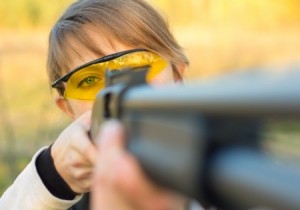How do you adjust your aim when your target is either high above you or far below you? You’re going to find lots of opinions out there that are heavy on experience but light on science. But hopefully we can answer that question in this post.
 It’s simple to know how to compensate for a target that is farther out than your gun is sighted for. The same is true for compensating for a strong crosswind. What’s not so intuitive is figuring out how the trajectory of you bullet or arrow will change when you are shooting steeply downhill or uphill. Unfortunately, it’s a situation that all mountain hunters will face.
It’s simple to know how to compensate for a target that is farther out than your gun is sighted for. The same is true for compensating for a strong crosswind. What’s not so intuitive is figuring out how the trajectory of you bullet or arrow will change when you are shooting steeply downhill or uphill. Unfortunately, it’s a situation that all mountain hunters will face.
Most of the time, we get away with a guess, thanks to flat-shooting high-power rifles or fast-shooting bows. However, there are situations when the target is at the extreme range of our weapon. That’s when aiming precision is critical. Here are a few websites that provide some solid science to support their conclusions.
After powering through a series of mathematical equations, Perry Ratcliff of Archer’s Advantage summarized his findings in this way: The most common rule given is that you set your sight for the horizontal component of the range. For example, if you were shooting a 60-yard uphill/downhill shot at a 20-degree angle, you would set your sight for 56.4 [COS(20°) * 60 ~ 56.4] yards regardless of whether the target is at an uphill or downhill angle. Did you get that? Aim for a shorter distance.
Steve Russell of Kings Mountain Archers summarized his mathematical calculations with the following example: If you were shooting a 40-yard uphill shot at a 30-degree angle, you would set your sights for about 35 yards (the cosine of the 30-degree angle times the line-of-sight distance to the target, which in this case comes to 0.866 times 40 yards, or 34.6 yards). The trajectory of a downhill shot is the same as that of an uphill shot, says Russell. The conclusion: Aim lower.
The following websites address aiming points for rifles: William McDonald of Exterior Ballistics.com stated that “in an angled situation, a gun will always shoot high compared to shooting on a level trajectory.” Len Backus of Long Range Hunting Online Magazine says, “There is a physical ballistic problem encountered when shooting at angles that causes the bullet’s point of impact to hit high.” The solution? Aim lower. An article on “How to Compensate for Uphill/downhill Shooting” by Firearmsite.com states, “When shooting uphill, you have to hold your sights below the target in order to hit the target. A similar effect occurs when shooting downhill. To compensate for shooting downhill, you must also aim below the target.
The consensus of opinions from multiple sources indicates that for either uphill or downhill shots, aim lower than you would do otherwise.
